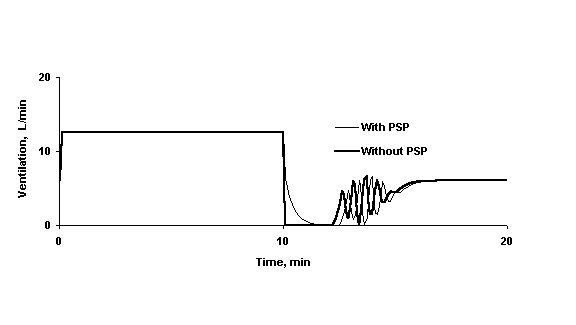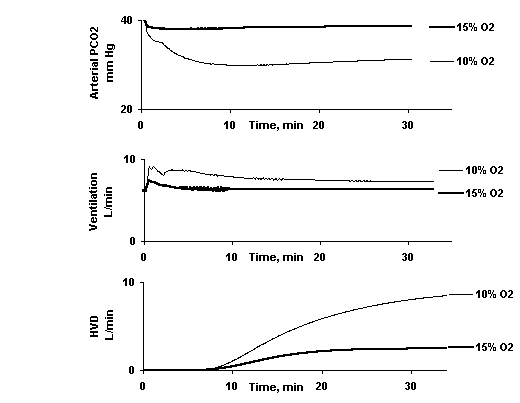Figures
3/31/02 last updated


Fig. 1 A. Comparison of the chemical controller characteristic for the Cheyne-Stokes and the current continuous model. The chemical controller characteristic in the Cheyne-Stokes model goes to zero ventilation at PCO2 values that vary with PO2 while in the continuous controller model the chemical controller has no zero ventilation thresholds.
B. The effect of alertness factors on ventilation. As alertness factors decrease, the ventilation threshold for the chemical controller characteristic is lowered so that the possibility for apneas increases and the controller characteristic becomes that of the Cheyne-Stokes model.



Fig. 2. The effect of alertness factor on breathing after voluntary hyperventilation. Higher alertness factors increase damping of the ventilatory response. As the alertness factor is reduced the response becomes more oscillatory and apneas appear. Voluntary hyperventilation starts at zero time and ends at 10 minutes

Fig. 3. The effect of raising the transition PCO2. Raising the transition PCO2 reduces oscillations in the post-hyperventilation period. The ventilatory response for a transition PCO2 of 36.75 mm Hg is highly oscillatory, while that for a transition PCO2 of 38.5 mm Hg is comparatively damped, with only several small amplitude oscillations. Alertness factor is -2 liters/minute.

Fig. 4. Comparison of the ventilatory response after voluntary hyperventilation during quiet wakefulness with and without PSP. PSP prevents a sudden drop in ventilation and an apnea of about two minutes duration in the immediate period following the end of voluntary hyperventilation. After that the responses with and without PSP are essentially the same.

Fig. 5. The effect of alertness factor on the ventilatory response after two minutes of breathing 8% O2. The short-term hypoxia of 2 minutes of 8% is followed by 37% O2. Higher alertness factors increase damping of the ventilatory response. As the alertness factor is reduced the response becomes more oscillatory and apneas appear. Under both circumstances the effects of PSP are included

Fig. 6. Arterial PCO2, ventilation and hypoxic ventilatory depression while breathing 10% and 15% O2, during quiet wakefulness. Ventilation peaks almost immediately after the disturbance then declines, as HVD develops, to a steady state value. Arterial PCO2 declines to a minimum then rises to a steady state value, mirroring the pattern of ventilation.

Fig 7. Ventilatory response in the transition from wakefulness to sleep while breathing 15% O2. Awake, alert ventilation during long term hypoxia while breathing 15% O2 is stable. However, sleep is destabilizing. The drop in oxygen saturation during sleep to an average of 89.4 % from 93% awake raises the controller CO2 gain from 2.7 to 3.5 liters/minute/mm Hg of PCO2 in sleep, enough to cause the instability. Even without HVD the ventilatory response is unstable. The alertness factor awake is 0 liters/min, the alert state, and asleep it is -11.5 liters/min.









